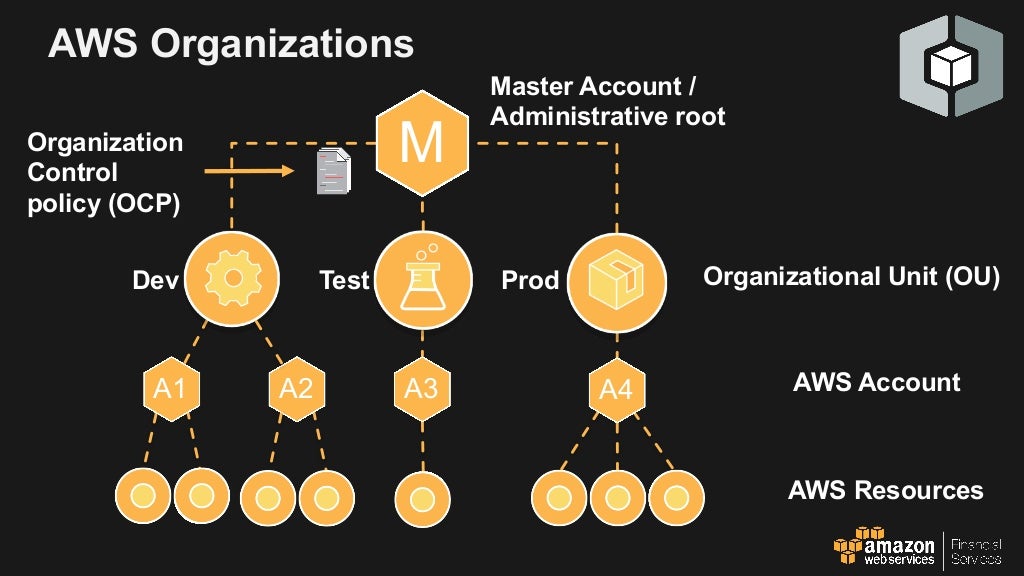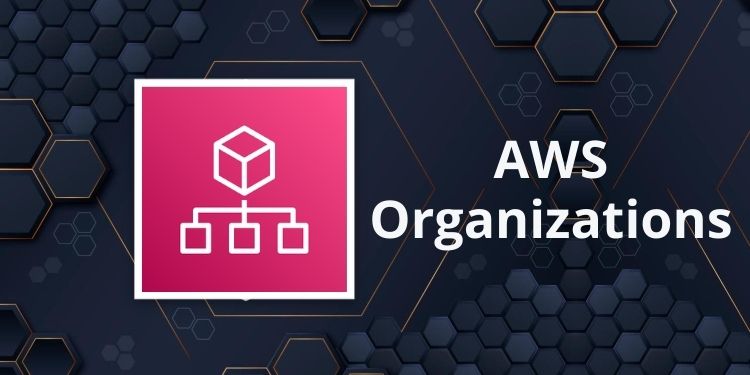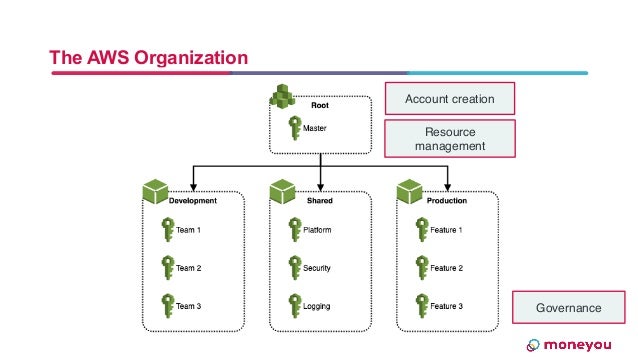The Impact of a Sound AWS Organization Structure
A well-defined AWS organization structure is crucial for organizations utilizing Amazon Web Services (AWS) for their cloud infrastructure. This structure plays a significant role in managing costs, ensuring security, and maintaining governance. By establishing a robust AWS organization structure, businesses can streamline their operations, minimize risks, and optimize resource allocation.
Demystifying AWS Organizations: Understanding the Basics
AWS Organizations is a service that enables businesses to manage multiple AWS accounts from a single, centralized location. This structure simplifies the management of resources, enhances security and compliance, and streamlines billing processes. The two main components of AWS Organizations are the master account and member accounts.
The master account serves as the primary account, providing the administrative interface for managing all member accounts. It also enables the creation and management of service control policies (SCPs), which define the permissions and limitations for AWS services across all member accounts.
Member accounts, on the other hand, represent individual AWS accounts that can be used for various purposes, such as development, testing, or production environments. These accounts inherit permissions and limitations from the master account’s SCPs, ensuring consistent security and compliance policies throughout the organization.
How to Design an Effective AWS Organization Structure
Designing an optimized AWS organization structure is essential for efficient resource management, cost control, and security. Follow these steps to create an effective AWS organization structure:
- Account segmentation: Separate accounts based on business units, environments (development, testing, production), or projects. This approach simplifies resource management, cost tracking, and access control.
- Service control policies (SCPs): Implement SCPs to define the maximum available permissions for accounts and prevent unauthorized access or actions. Regularly review and update SCPs to maintain security and compliance.
- Tagging strategies: Implement consistent tagging conventions to categorize and track resources. Tags can be used for cost allocation, access control, and automation. Use AWS-recommended tagging best practices to ensure optimal results.
- Policy-based management: Leverage AWS Organizations’ policy-based management features to enforce consistent policies across accounts. This ensures that security, compliance, and cost management policies are uniformly applied throughout the organization.
- Monitor and adapt: Regularly review your AWS organization structure and make adjustments as needed. As your business grows and evolves, your AWS organization structure should be flexible enough to accommodate new services, accounts, and access requirements.
Managing Access and Permissions within AWS Organizations
Managing access and permissions within an AWS organization structure is crucial for maintaining security and ensuring proper resource utilization. IAM roles, permissions, and policies play a significant role in controlling access to AWS resources.
IAM roles are used to delegate access to users or services within your AWS organization. By defining IAM roles with specific permissions and policies, you can ensure that users and services have the required access levels to perform their tasks without compromising security. To delegate access, attach the IAM role to a group or user, and define the necessary permissions and policies for that role.
Permissions within AWS Organizations are managed using SCPs, IAM policies, and permissions boundaries. SCPs are applied at the organizational unit (OU) or account level and define the maximum available permissions for accounts and services. IAM policies are used to grant or deny access to specific AWS resources, while permissions boundaries limit the permissions that an IAM entity can have.
When managing access and permissions, it is essential to follow the principle of least privilege, granting only the minimum necessary permissions to perform a task. Regularly review and update permissions and policies to ensure they remain relevant and aligned with your organization’s security requirements.
Leveraging AWS Organizations for Cost Optimization
AWS Organizations provides several features to help manage costs across accounts, ensuring efficient resource utilization and cost optimization. By implementing a well-defined AWS organization structure, you can effectively manage costs and allocate resources according to your business needs.
Consolidated billing
Consolidated billing allows you to view and manage costs across all your AWS accounts in a single bill. This feature simplifies cost tracking, provides detailed cost reports, and enables you to take advantage of volume pricing for various AWS services.
Cost allocation
Cost allocation tags can be used to categorize and track costs for specific resources or services within your AWS organization. By applying cost allocation tags consistently across all accounts, you can generate detailed cost and usage reports, making it easier to manage and optimize costs.
Budgets and alerts
AWS Organizations enables you to create budgets and alerts at the master account level, which can be applied to all member accounts. This feature helps you monitor and control costs, ensuring that you stay within your budget and avoid unexpected charges.
Reserved instances and savings plans
By leveraging reserved instances and savings plans at the organizational level, you can optimize costs for services with predictable usage patterns. These cost-saving strategies can be applied across all accounts, ensuring consistent cost optimization throughout your AWS organization structure.
To optimize costs within your AWS organization structure, regularly monitor and analyze cost reports, identify underutilized resources, and take advantage of cost-saving strategies such as reserved instances, savings plans, and spot instances. By doing so, you can maintain a cost-effective and efficient AWS environment.
Implementing Security Best Practices in AWS Organizations
Security is a critical aspect of any AWS organization structure. Implementing best practices within the AWS organization structure can help ensure data protection, maintain compliance, and prevent unauthorized access. Here are some best practices to consider:
Enable AWS Organizations’ security features
AWS Organizations offers various security features, such as service control policies (SCPs), which allow you to centrally manage permissions across all accounts in your organization. By defining and applying SCPs, you can ensure that your accounts comply with your organization’s security policies.
Implement multi-factor authentication (MFA)
MFA adds an extra layer of security to your AWS accounts by requiring users to provide a second form of authentication in addition to their password. Enforcing MFA for all IAM users and administrators can help prevent unauthorized access to your AWS resources.
Encrypt sensitive data
Data encryption is essential for protecting sensitive information within your AWS environment. Use encryption techniques such as server-side encryption (SSE) or client-side encryption to secure data at rest and in transit. Additionally, consider using AWS Key Management Service (KMS) to manage encryption keys and enforce access controls.
Regularly review and update security policies
Regularly review and update your security policies to address new threats and vulnerabilities. Monitor security events and alerts using AWS Organizations’ auditing and monitoring tools, and take appropriate actions to maintain a secure AWS environment.
Implement least privilege principle
Follow the principle of least privilege, granting only the minimum necessary permissions to perform a task. Regularly review and update IAM roles, permissions, and policies to ensure they align with the current security requirements and follow the least privilege principle.
By implementing these security best practices within your AWS organization structure, you can maintain a secure and compliant environment, protecting your organization’s data and resources.
Monitoring and Auditing Your AWS Organization Structure
Monitoring and auditing your AWS organization structure is crucial for maintaining security, enforcing policies, and ensuring compliance. AWS Organizations provides several tools and features to help you effectively monitor and audit your environment.
AWS Organizations’ auditing and monitoring tools
AWS Organizations integrates with various auditing and monitoring tools, such as AWS CloudTrail, AWS Config, and AWS Security Hub. These tools enable you to track changes, enforce policies, and monitor for potential security risks within your AWS environment.
AWS CloudTrail
AWS CloudTrail records API calls and user activity within your AWS organization structure. By enabling CloudTrail for all accounts in your organization, you can monitor and audit actions taken by IAM users, administrators, and services. CloudTrail logs can be used to identify unauthorized access, policy violations, or other security events.
AWS Config
AWS Config provides a detailed inventory of your AWS resources and their configurations. By recording configuration changes and evaluating them against custom rules, AWS Config helps you maintain compliance and enforce best practices within your AWS organization structure.
AWS Security Hub
AWS Security Hub aggregates security findings from multiple AWS services, including AWS Config, Amazon GuardDuty, Amazon Inspector, and Amazon Macie. By providing a unified view of your security posture, Security Hub simplifies the process of monitoring and auditing your AWS environment.
Monitoring and auditing best practices
To effectively monitor and audit your AWS organization structure, follow these best practices:
- Enable CloudTrail, Config, and Security Hub for all accounts in your organization.
- Regularly review and analyze logs, security findings, and configuration changes.
- Create custom rules and alerts to detect potential security risks or policy violations.
- Integrate monitoring and auditing tools with your existing security information and event management (SIEM) systems.
- Establish a regular schedule for reviewing and updating your security policies and best practices.
By implementing these monitoring and auditing best practices, you can maintain a secure and compliant AWS environment, ensuring that your organization structure adapts and scales as your business grows and evolves.
Scaling and Adapting Your AWS Organization Structure
As your business grows and evolves, so will your AWS environment. Adapting and scaling your AWS organization structure is essential to accommodate new services, manage access for external partners, and maintain a secure and cost-effective infrastructure. Here are some strategies to help you scale and adapt your AWS organization structure.
Integrating new services
As you adopt new AWS services, ensure they are properly integrated into your organization structure. This includes updating service control policies (SCPs), IAM roles, and tagging strategies to maintain consistency and control across your environment. Regularly review and update your organization structure to accommodate new service integrations and ensure they align with your security and cost management goals.
Managing access for external partners
When collaborating with external partners, it’s essential to establish appropriate access controls. Leverage IAM roles and permissions to delegate access to specific resources without compromising security. Implement multi-factor authentication (MFA) and data encryption for sensitive data shared with external partners. Regularly review and update access controls to ensure they remain relevant and secure.
Monitoring and auditing
Monitoring and auditing your AWS organization structure is crucial for maintaining security, enforcing policies, and ensuring compliance as your environment grows. Utilize AWS Organizations’ auditing and monitoring tools, such as AWS CloudTrail, AWS Config, and AWS Security Hub, to track changes, enforce policies, and monitor for potential security risks. Regularly review and analyze logs, security findings, and configuration changes to identify areas for improvement and optimization.
Scaling cost management strategies
As your AWS environment expands, it’s essential to scale your cost management strategies accordingly. Leverage AWS Organizations’ cost optimization features, such as consolidated billing, cost allocation, and budgets, to maintain control over your growing infrastructure. Regularly review and adjust your cost management strategies to ensure they remain effective and efficient as your business evolves.
Continuous improvement
Scaling and adapting your AWS organization structure requires continuous improvement and optimization. Regularly review your organization structure, identify areas for improvement, and implement best practices to maintain a secure, cost-effective, and governable environment. Stay up-to-date with AWS Organizations’ features and capabilities, and consider engaging with AWS experts or consulting services to help you optimize your organization structure for long-term success.







